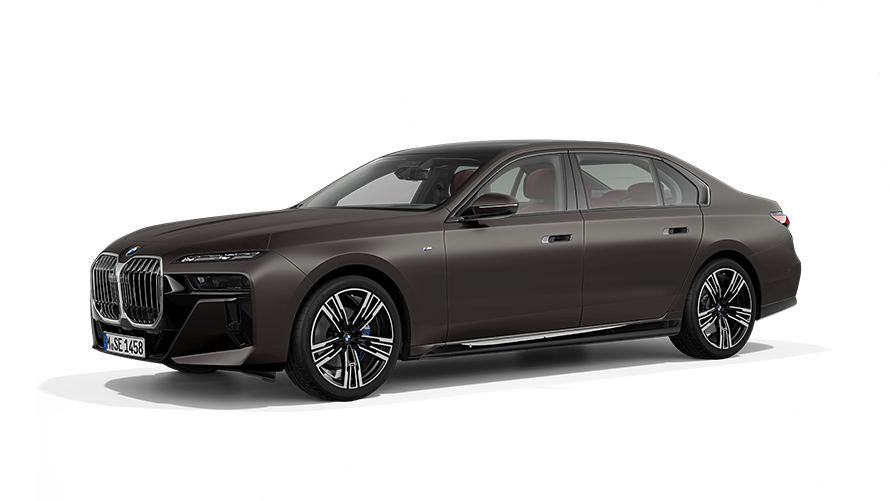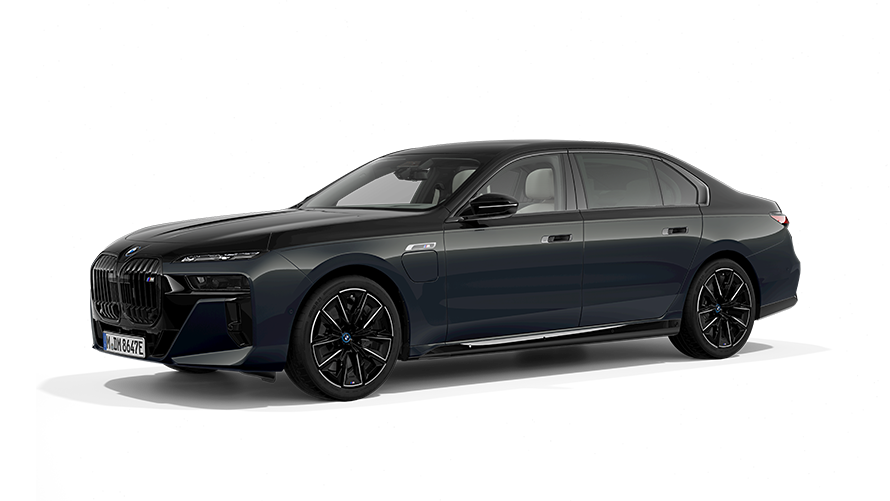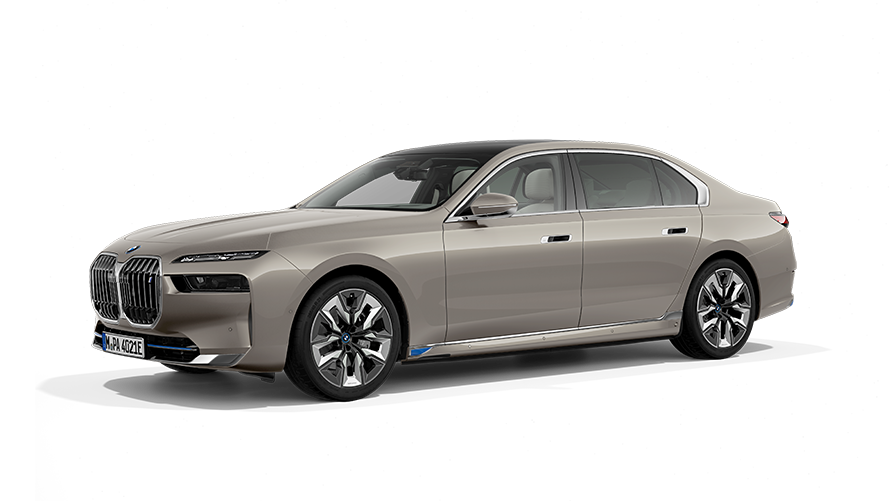Our tool for managing your permission to our use of cookies is temporarily offline. Therefore some functionality is missing.
THE LATEST BMW 7 SERIES.
For many decades, BMW has been the number one choice in the luxury sedan class. You don't have to compromise on sportiness, driving dynamics, luxury or comfort – these are the fundamental elements that make the BMW 7 series unique. Outstanding driving experience, exclusive materials and stylish design characterize this high-end vehicle.
The all-new BMW 7 Series stands for an extraordinary presence, maximum performance and unique comfort. Its self-confidence is underlined by the impressive front with the characteristic kidney grille. At the sides, the Air Breather emphasises its distinctive character. With extended stitching and the high-quality interior trim strips, the interior offers an especially luxurious ambience.
The BMW 7 Series also extends driving pleasure and safety by means of digital and automated functions and assistants. BMW Personal CoPilot combines numerous driver assistance systems that help the driver in various situations and completely take over certain tasks. With the BMW Live Cockpit Professional including Operating System 7.0, the control becomes even easier and more intuitive.
In addition to the BMW TwinPower Turbo 6-cylinder or the powerful 8-cylinder petrol engine, the BMW 7 Series Sedan with the BMW 745e/Le plug-in hybrids combines the impressive performance of the BMW TwinPower Turbo inline 6-cylinder engine and the pioneering efficiency of the latest generation high-voltage battery.
The new BMW M760Li xDrive Sedan with the powerful BMW TwinPower Turbo 12-cylinder petrol engine unites elegance and sportiness. In combination with the M Sport package as well as exclusive M Performance equipment and numerous design elements, it shifts the focus onto the passion for dynamics.
BMW 7 SERIES OVERVIEW.
No matter what the occasion, the BMW 7 series makes a brilliant entrance. Its sublime presence and self-confident character reflect the tradition, experience and perfection expected in the luxury segment. The vehicle’s exceptional drive and technological superiority show how new, higher standards in performance, comfort and dynamics can be achieved again and again.
4 CHARACTERISTICS OF THE BMW 7 SERIES.
- 01 Supreme, confident appearance
- 02 No compromises in comfort and luxury
- 03 Exceptional performance in every respect
- 04 Cutting-edge vehicle technology
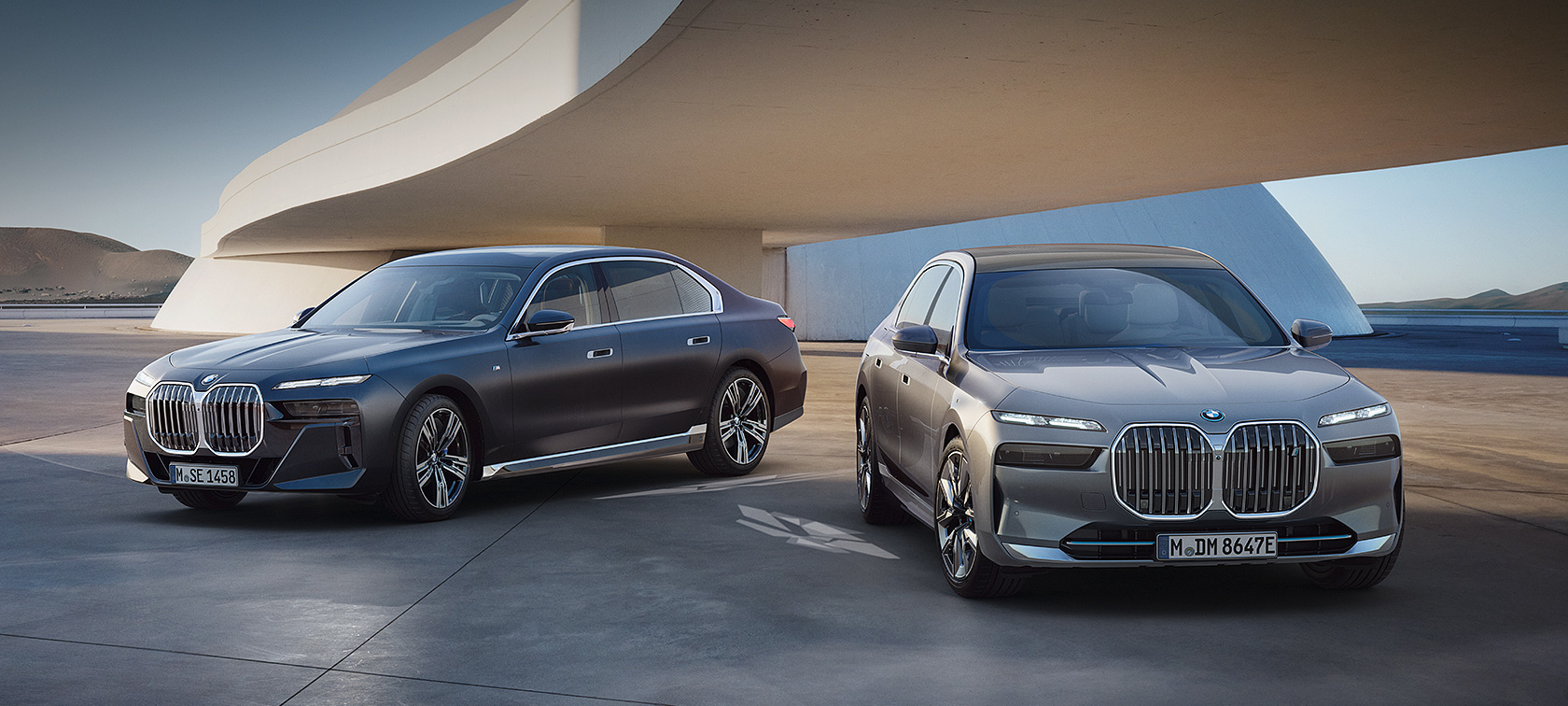
A BRIEF HISTORY OF THE BMW 7 SERIES.
Discover the origins and history of the high-end vehicle from BMW. Experience the evolution and development of the sedan that sets the standards in performance, luxury and design.
A BRIEF HISTORY OF THE BMW 7 SERIES.
Discover the origins and history of the high-end vehicle from BMW. Experience the evolution and development of the sedan that sets the standards in performance, luxury and design.
THE FIRST GENERATION BMW 7 SERIES.
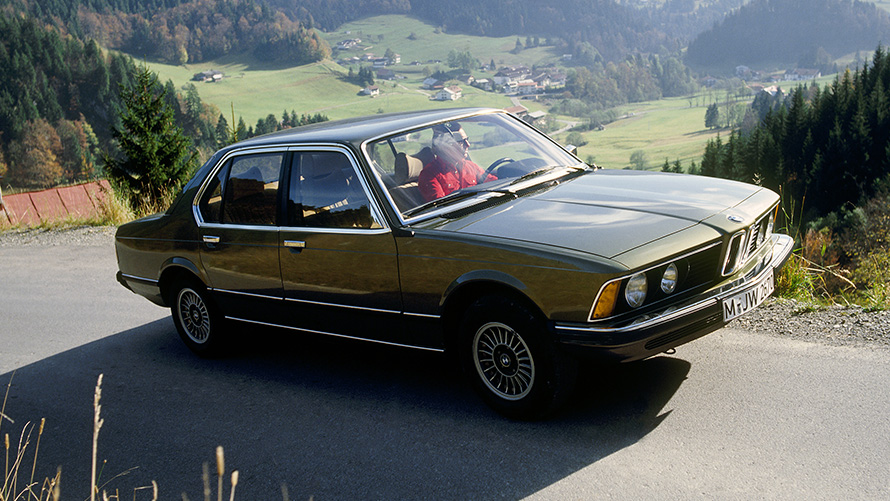
(BMW E23)
The BMW 7 series was born in 1977. A vehicle that embodies dynamic sportiness, innovative technical progress and elegant luxury at the highest level. The successor to the BMW E3 series has 6-cylinder engines which show incomparable refinement and performance at every power stage and make the car the sportiest sedan in the high-end class. The body shape is based on a design by Paul Bracq and is characterized by the sloping front and rear sections, which, like the low beltline, underline the sportiness of the luxury sedan.
Modern features such as an electronic climate control system and cruise control are available as early as 1978, with an anti-lock braking system (ABS) and digital engine electronics following in 1979. In the same year, all engines are converted to gasoline-injection.
1980 sees the release of the top-of-the-range model: The BMW 745i delivers 185 kW (252 hp) to achieve a top speed of 227 km/h. The 1982 model update features a modified, even more aerodynamic front, four-speed automatic transmission and a reworked chassis. Over nine years more than 270,000 vehicles leave the factory, and the highly-successful series continues the dominance of BMW in modern luxury-class sedans.
Production period: 1977–1986
Engines: 2.5–3.4 liters (110–185 kW, 150–343 hp), 6-cylinder
Length/width/height: 4,860 mm/1,800 mm/1,430 mm
THE SECOND GENERATION BMW 7 SERIES.
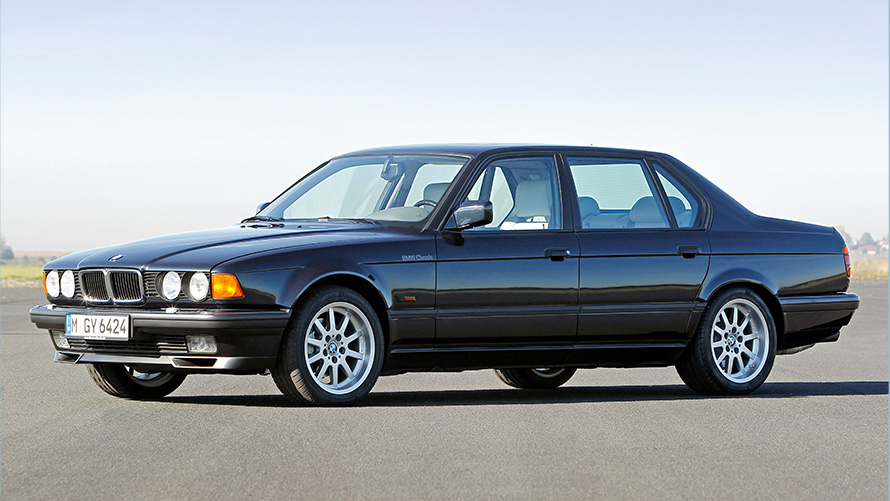
(BMW E32)
Under the design leadership of Claus Luthe, the second BMW 7 series model incorporates harmonious lines and dynamic, confident style elements. The wide kidney on the front, for example, or the imposing rear, whose L-shaped taillights further underline the look. The BMW 7 series now comes with ABS as standard together with optional Park Distance Control and dual pane glass, which significantly reduces noise levels and ensures mist-free windows.
From 1987, the high-end sedan is available with a 5.0 liter V12-cylinder engine that delivers 220 kW (300 hp). The engine is the first of its kind to be used in German automobile manufacturing since 1945. The BMW 7 series is now also available in a longer version for maximum comfort for rear seat passengers. From 1989, the new High Line optional extra takes luxury to a new level with equipment such as an on-board refrigerator and a car phone.
For the first time in a production vehicle, Xenon lighting is available as an option from 1991 onwards. In 1992 a major model update is introduced. Subsequently, two 8-cylinder engines with three and four liter displacement complete the engine range. Around 310,000 vehicles are built by 1994.
Production period: 1986–1994
Engines: 3.0–5.0 liters (135–220 kW, 184–300 hp), 6-, 8- & 12-cylinder
Length/width/height: 4,910–5,024 mm/1,845 mm/1,400–1,411 mm
THE THIRD GENERATION BMW 7 SERIES.
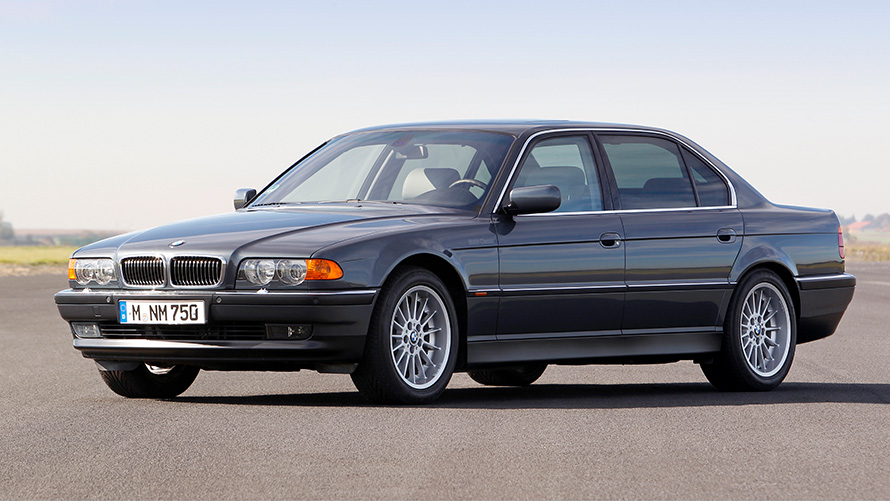
(BMW E38)
The new generation of the BMW 7 series arrives in the showrooms in 1994 and boasts a range of technical innovations. It is the first European car with a navigation system and, from 1996, has side airbags for the driver and front passenger as standard. Front airbags protect rear seat passengers from 1997. The design is wider and sportier, but also more elegant.
It is the first BMW 7 series model available with a diesel engine, with a 6-cylinder engine that delivers 135 kW (184 hp), assisted by common rail technology. From 1996, a 6-cylinder diesel engine with a 2.5 liter displacement and 105 kW (143 hp) serves the lower diesel engine range. And in 1999 the high-end sedan with a V8 diesel engine and a power output of 180 kW (245 hp) sets a further record: The vehicle is the most powerful diesel passenger car ever.
The BMW 750i/750iL spearheads performance: Its twelve cylinders with 5.4 liter displacement generate 240 kW (326 hp). The 1998 model update features more dynamic headlights and rear lights, as well as redesigned side sills and a slightly wider kidney. The engine range is reworked, and assemblies become more efficient and, at the same time, more powerful. From 2000, the BMW 7 series is the home for a new engine technology: The BMW 750hL is produced on a small scale and uses hydrogen. In addition to the regular long-wheelbase version, around 900 vehicles are manufactured under the name L7 and are a total of 39 centimeters longer than the standard version. A total of 327,000 BMW 7 series (E38) are produced.
Production period: 1994–2001
Engines: 2.5–5.4 liters (105–240 kW, 143–326 hp), 6-, 8- & 12-cylinder
Length/width/height: 4,984–5,374 mm/1,862 mm/1,425–1,435 mm
THE FOURTH GENERATION BMW 7 SERIES.
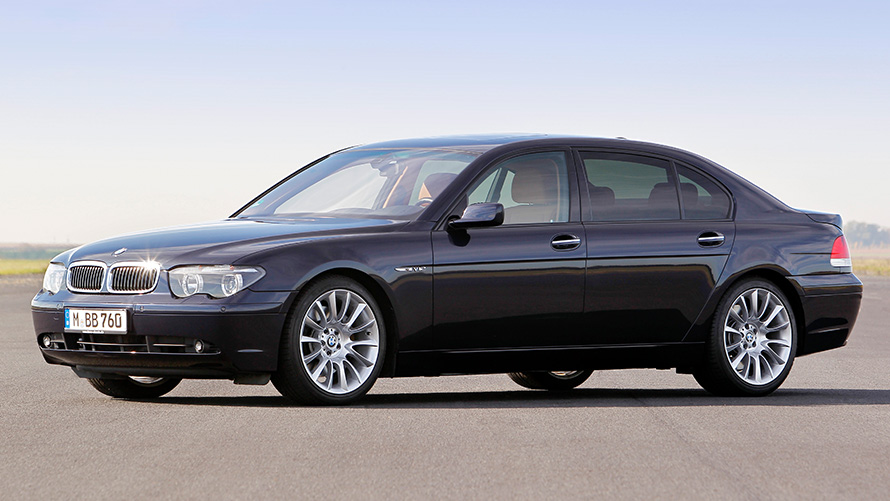
(BMW E65, E66, E67 and E68)
Launched at the 2001 International Motor Show (IAA) in Germany, the new BMW 7 series (E65) is a completely new vehicle in every respect. Chris Bangle’s team create design accents with the totally redesigned headlights and the characteristically offset trunk lid. Inside, the iDrive system provides the driver with an unprecedented operating environment. There are fewer control buttons. Instead around 700 functions covering the vehicle's extensive and diverse systems can be accessed via a single button that can be turned, pushed and moved in eight directions. The on-board computer uses information from the internet. Another innovation has its worldwide premiere: A six-speed automatic transmission with a gear selector on the steering wheel. The top-of-the-range engine now produces 327 kW (445 hp), which the 12-cylinder engine draws from six liters of displacement.
From 2003 the BMW 7 series with adaptive cornering lights is available, and a major model update is undertaken in 2005. Visually, the rear is wider, the kidneys are bigger, and Bi-Xenon headlamps are now standard equipment. They also have a much more dynamic design. The iDrive system is updated and can now be operated more efficiently. In the fall of 2005, a high-beam assistant is added as well as Night Vision, the BMW night assistant which helps to improve safety in the dark.
In addition to the sedan (E65), the various model designations also include the long version with a 14 centimeter longer wheelbase (E66), a high-security version (E67), and the hydrogen-powered version (E68).
Production period: 2001–2008
Engines: 3.0–6.0 liters (160–327 kW, 218–445 hp), 6-, 8- & 12-cylinder
Length/width/height: 5,039–5,179 mm/1,902 mm/1,491 mm
THE FIFTH GENERATION BMW 7 SERIES.
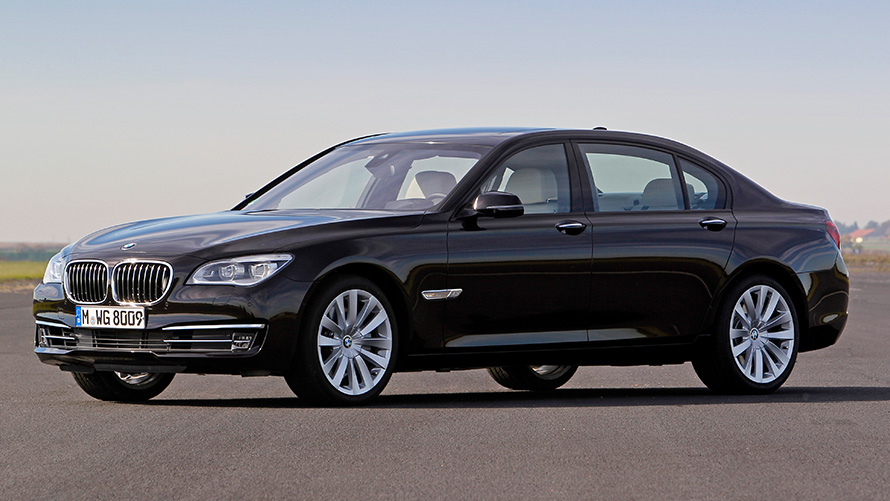
(BMW F01/F02)
At its launch in Munich the BMW 7 series (F01) defines a new standard for combining superior driving dynamics, outstanding presence and exceptional travel comfort. The elegant and sporty design is reflected in the long hood, the low roof line and dynamic proportions. A chrome band extends across the entire rear which, together with the rear lights, accentuates the width of the vehicle.
The interior boasts exclusive, exceptionally-crafted materials and a multitude of modern assistance systems: From active cruise control and lane assist to the head-up display. Additional safety is provided by cameras that show the rear view and can also provide an all-round view. This option generates a picture of the vehicle from above, guaranteeing the best possible overall view.
Diesel and gasoline engines provide sporty performance, including double-charged turbo engines and the BMW 760i, whose V12-cylinder engine delivers 400 kW (544 hp). And for the first time, a hybrid drive is available in the BMW 7 series. The optional four-wheel drive, Adaptive Roll Stabilization and Electronic Damper Control (EDC) all contribute to the typical BMW driving dynamics – for safe, precise driving.
The 2012 model update brings a new central display with 3D visuals, redesigned assistance systems including the LED high-beam assistant, and reworked, more efficient engines.
Production period: 2008–2015
Engines: 3.0–6.0 liters (180–400 kW, 245–544 hp), 6-, 8- & 12-cylinder
Length/width/height: 5,072–5,212 mm/1,902 mm/1,479 mm
THE SIXTH GENERATION BMW 7 SERIES.
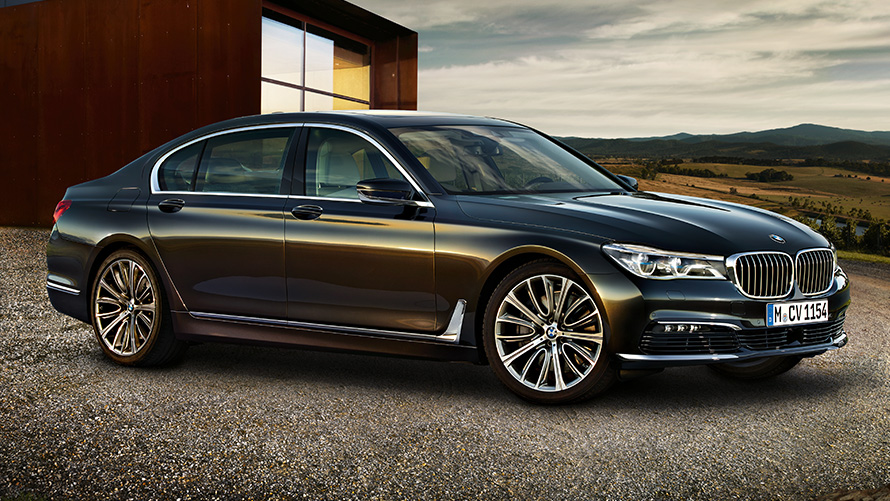
(BMW G11/G12)
Manufactured from 2015, the BMW 7 series (G11) combines superior dynamics and precision with an exceptional presence and exclusive luxury. This is evident in the opulent, shimmering paint finishes and the striking design at the rear. Flat LED lights are connected by a narrow band of light and project a confident appearance, reinforced by the exhaust tailpipes with their trapezoid contours and wide positioning. The body consists of a composite of CFRP (carbon fiber reinforced plastic), steel and aluminum, saving a considerable amount of weight. A panoramic roof is available in the long-wheelbase version (G12), which provides ventilation with its slide and lift function. As a Sky Lounge, it also shows colored graphics, which harmonize perfectly with the light accents on the B-pillar. And on approach, the BMW 7 series greets the driver with a “Welcome & Goodbye” light show.
Exclusive, highly crafted materials express your personal preferences – for instance Nappa leather upholstery with “Cognac” quilting, complementary interior trims and the roof lining. The rear passenger entertainment system is equipped with HD touch screens. With the Executive Lounge option, rear passengers enjoy maximum comfort thanks to the luxurious seats with adjustable massage functions. Occupants sitting behind the front passenger have an unobstructed panoramic view, and their footrest is attached to the front passenger seat.
Semi-automated parking gives the driver control of the vehicle without being in it: The BMW 7 series can maneuver itself into parking spaces and garages with driver supervision.
With the model update in 2019 the car was given a new, significantly larger radiator grille, which, together with the matching headlights emphasize the width and presence of the luxury sedan.
Production period: 2015–today
Engines: 2.0–6.6 liters (183–448 kW, 249–610 hp), 4-, 6-, 8- & 12-cylinder
Length/width/height: 5,098–5,260 mm/1,902 mm/1,467–1,479 mm
Fuel consumption and CO2 emissions.
BMW i7 Sedan:
Electricity consumption in kWh/100 km (combined): 19.6–18.4
Electric Range in km: 591–625BMW M760Li xDrive Sedan:
Fuel consumption in l/100 km (combined): 10.2
CO2 emissions in g/km (combined): 233The values of fuel consumptions, CO2 emissions and energy consumptions shown were determined according to the European Regulation (EC) 715/2007 in the version applicable at the time of type approval. The figures refer to a vehicle with basic configuration in Germany and the range shown considers optional equipment and the different size of wheels and tires available on the selected model.
The CO2 efficiency specifications are determined according to Directive 1999/94/EC and the European Regulation in its current version applicable. The values shown are based on the fuel consumption, CO2 values and energy consumptions according to the NEDC cycle for the classification.
For further information about the official fuel consumption and the specific CO2 emission of new passenger cars can be taken out of the „handbook of fuel consumption, the CO2 emission and power consumption of new passenger cars“, which is available at all selling points and at https://www.dat.de/angebote/verlagsprodukte/leitfaden-kraftstoffverbrauch.html.
